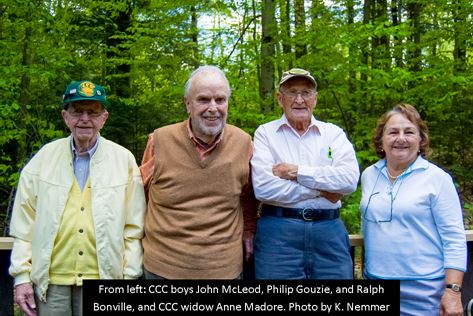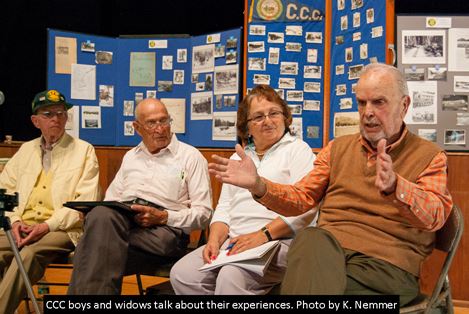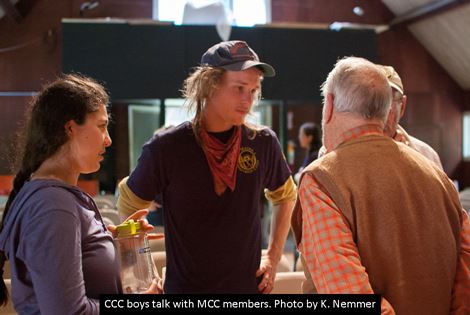
Story and photos from Maine Conservation Corps
2013 marks the 80th anniversary of the Civilian Conservation Corps (CCC). The CCC was a work-relief program instituted in 1932 by President Franklin Delano Roosevelt. Over the eleven years of the program, three million young men served in the CCC. In Maine, they worked in the woods, built roads, cut fire trails, and performed all types of conservation work. They were paid $30 per month, of which $25 had to be sent home to their families. On Thursday, May 16, 2013, at Camp Mechuwana in Winthrop, a recognition event was held by the Maine Conservation Corps (MCC) to honor the service of the CCC members in Maine.
The MCC is an AmeriCorps program that performs conservation work throughout Maine. The MCC continues the CCC’s tradition of conservation service. This year is the 30th anniversary of the MCC.
The honorees in attendance at the event were Ralph Bonville, John McLeod, Philip Gouzie, and Anne Madore, Peter Madore’s widow. All the CCC Boys in attendance served in the armed forces in World War II after leaving the CCC. Eighty-five percent of those who served in the CCC across the country went on to serve in the military during World War II.

Other speakers included MCC Director Jo Orlando, Congressman Michael Michaud’s Deputy Chief of Staff John Graham, Jr., Maine Commission for Community Service Director Maryalice Crofton, Bureau of Parks and Lands Director Willard Harris, and Supervisor of Outdoor Recreation Mick Rogers.
Maine Department of Agriculture, Conservation, and Forestry Commissioner Walter Whitcomb presented each of the honorees with the President’s Call to Service Award. This highest level volunteer service award is for extraordinary service, at least 4000 hours over a lifetime. They also received the service award pin and congratulatory letters from President Obama and AmeriCorps director, Bill Basl.
Ralph Bonville, age 94, joined the CCC after high school because of the lack of other work. He served in the “Far East” CCC camp in Princeton, Maine. The CCC built part of the Stud Mill Road in that area to aid in firefighting. His job was shoveling. Often the ground was frozen and had to be dynamited. After leaving the CCC Bonville served in the Army. He went on to become a 2nd generation painter.

John McLeod, age 89, joined the CCC in 1940 and served in Camden Hills camp. He helped build Camden Hills State Park, from the buildings to the trails to the picnic area by the water. He then served as a camp hospital orderly, which paid and extra $6/month. After the Camden camp closed in 1941 McLeod was transferred to the camp in Bar Harbor, where he continued to serve as a hospital orderly until the CCC program ended in 1942, when he assisted in the final inventory. After the CCC, McLeod worked as a shipyard welder, a skill he learned in the CCC, and then he served in the United States Marine Corps.
Anne Madore spoke about her late husband, Peter. He was the 8th of 13 children. Their mother had died young, and the father was raising the children by himself. Many of Peter’s siblings also joined the CCC. He served in the Princeton camp, where he learned how to fell trees, use dynamite, build stone walls, and all type of construction work. These skills served him well for the rest of his life as he pursued a career in construction. He had many of the skills and knowledge that his younger coworkers did not, and he taught them everything. After leaving the CCC, Peter Madore served in the U.S. Army in the South Pacific, where he was awarded the Bronze Star for heroism.
Philip Gouzie, age 90, is a Former Vice President of the National Association of CCC Alumni, CCC Legacy Board Member, President of CCC Legacy Chapter 111. He served in the 1124th CCC Company, in Bridgton, Maine. The Bridgton camp was administered by the Forest Service with a focus on insect and disease control. Gouzie talked about looking for gypsy moth egg clusters and painting them with creosote to kill them. He talked about how the boys searched the treetops using ropes and looked under barns, etc. He also delivered food to the boys serving in the field, helped maintain the motor pool, ran the movie projector at the camp, and also served as a helper to the camp doctor. He served in the Navy, in the Submarine Service, during and after World War II.





































































